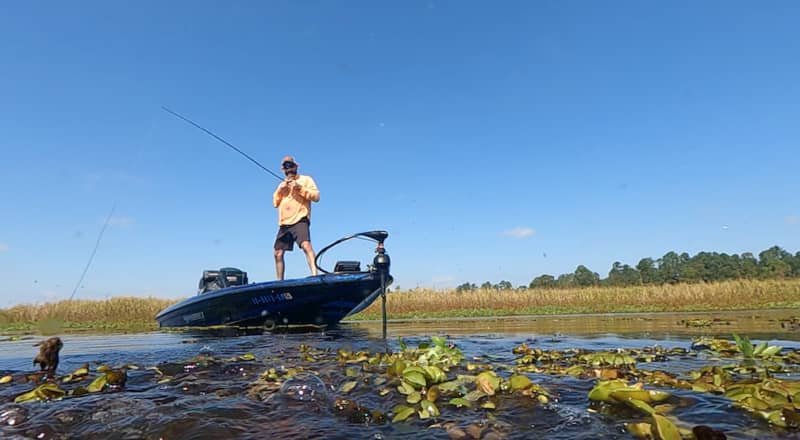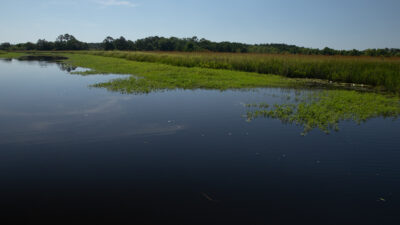Alligator Grass Bass
Keith Lusher 06.07.23

As the temperature rises with the turn of the calendar from May to June, anglers are changing the way they fish. Thermoclines, moving water, and shade are all factors that play into the equation when it comes to bass fishing. Chris Basey of Covington, La, admits that it can be a challenge, especially in South Louisiana, for fishermen looking to catch bass in the heat of the summer. But he utilizes a method that’s been proven to produce loads of bass and it all starts with finding a type of aquatic vegetation he calls “alligator grass.”
Its official name is Alligator Weed and it is often seen in warmer states where water temperatures can reach the mid-80s. It forms dense mats with its leaves being 3-5 inches in size. A dead giveaway for spotting Alligator Weed is the small white flower that is produced on a spike that resembles clover blooms. The vegetation originally came from South America but has found a home in the Gulf South States. Now it is virtually indestructible because of its ability to spread with ease. When a section of the plant breaks off, any part that touches the soil underwater begins to set roots and grow into a new plant. Fortunately, it is averse to cold weather which kills off the grass every winter.

During the summer months, Basey said the thick mats that the grass forms provide a shady, cool environment for bass that are looking to escape the summertime heat that can push water temps into the upper 80s and sometimes 90 degrees in South Louisiana.
On his latest trip, he found a large section of Alligator Grass that extended about 20 feet from the bank and spanned the entire shoreline. The water in the bayou was extremely clear which is a benefit to fishing water where the grass is prolific. “If you look underneath the grass you can see the root system which is basically like a filter. All of the cuts that I fish that have this grass contain clean water so it definitely cleans the water up,” he said.
Basey uses his punching set-up when fishing the grass which is a heavy rod with braided line tied to a 3/0 hook with a blue colored Berkley Pitt Boss threaded on. For a weight he uses a 3/4 oz sliding bullet weight with two bobber stoppers pegged close to the hook so the weight doesn’t slide up. “You want that lure to perform as one single piece when punching,” he said.

He uses an underarm stroke when he casts which allows the jig to propel high into the air. This causes the lure to gain speed when it falls, which causes it to power through the thick grass. Once the jig is under the grass, it’s all up to the bass to find it. And they usually do! “Hands down, I’ve caught my biggest bass punching mats with jigs,” Basey said. “There’s just something about hearing that line ripping through the grass and that big bass popping out. It can get a little messy but it’s worth it!”
Another benefit to fishing underneath these grass mats is the aggressiveness of the bass. The mats serve as cover for bass which in turn make the fish less weary to hit a lure. “When those bass are under the grass they are in ambush mode. Nothing’s going to stop them from jumping on this jig right here,” he said. “When I’m flipping, I get a lot of strikes right when the lure punches through the grass and sinks down. These bass aren’t shy because they feel like they’re hiding.”
While the grass produces bass, it can be a hassle to deal with after the hook-set. Basey often has to remind himself to set the hook harder than he would usually do when fishing other types of lures like topwater or crankbaits. “You always want to set the hook as if there’s a 7-pounder on the other end because it can be a battle getting him up out of that alligator grass,” he said. The significance of using a heavy rod with braided line becomes glaringly obvious when Basey is punching. “If you know that your line isn’t going to pop and your rod can handle any size fish, then it’s going to benefit you phsycologically when you set the hook and start yanking the bass to the boat,” he said.

Basey made a trip to the East Pearl River in Southeast Louisiana and said that the Alligator Grass is growing thick already and it’s shaping up to be a stellar year for those looking to punch mats for grass bass. He recommends getting off of the main rivers and bayous where the water is flowing. “I find that the dead-end cuts and bayous are better for fishing Alligator Grass,” He said. While the grass is in full fledge growth mode, Basey warns that it all comes to an end with that first cold front in Fall so get out there and punch while the weather’s warm!

